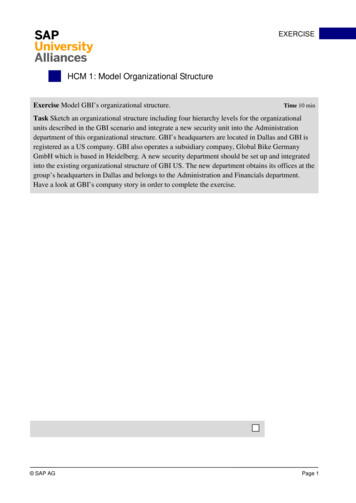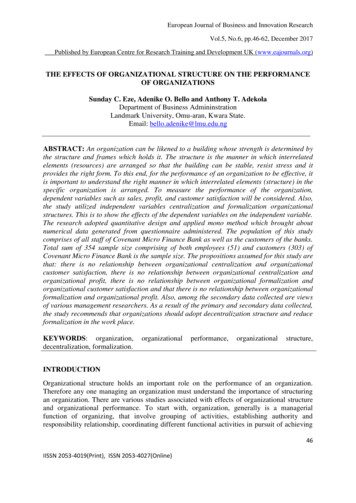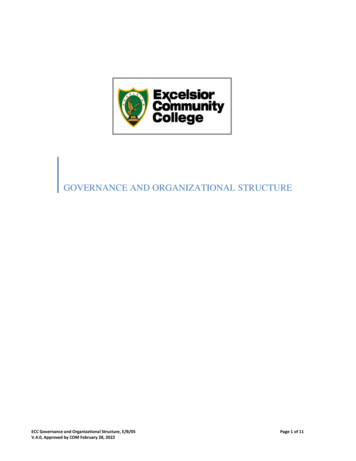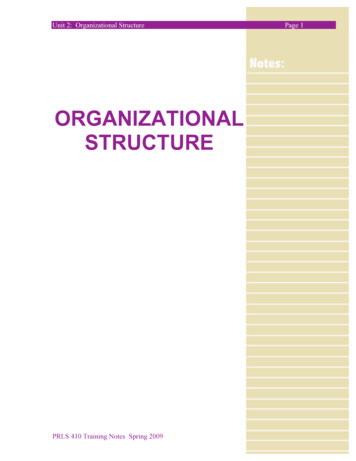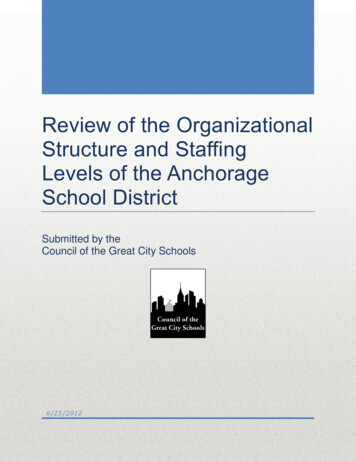
Transcription
Review of the OrganizationalStructure and StaffingLevels of the AnchorageSchool DistrictSubmitted by theCouncil of the Great City Schools6/25/2012
Review of the Organizational Structure and Staffing Levels of the Anchorage School DistrictTABLE OF CONTENTSAcknowledgments.5Chapter 1. Overview of the Anchorage School District .6Chapter 2. Goals and Purposes of the Project .18Chapter 3. Organizational Structure .22Chapter 4. Staffing Levels .30Chapter 5. Resource Deployment .44Chapter 6. Systems and Operations .53Chapter 7. Recommendations and Proposals .64Chapter 8. Synopsis and Discussion .73Attachment A. Technical Notes and Definition of Terms .76Attachment B. Strategic Support Team .82Attachment C. Documents Reviewed .87Attachment D. Individuals Interviewed .92Attachment E. About the Council .96Council of the Great City SchoolsPage 1
Review of the Organizational Structure and Staffing Levels of the Anchorage School DistrictExhibitsExhibit 1. Comparison of Anchorage, Alaska Excluding Anchorage, Alaska, Council of theGreat City Schools (CGCS), All Schools in the Nation Excluding CGCS, andAll Schools in the Nation, 2008-09 7Exhibit 2. Percentage of Students in the Anchorage School District Proficient in Readingon the SBA by Grade, 2007 to 2012 (Preliminary) . 8Exhibit 3. Percentage of Students in the Anchorage School District Proficient in Writingon the SBA by Grade, 2007 to 2012 (Preliminary). .8Exhibit 4. Percentage of Students in the Anchorage School District Proficient in Mathon the SBA by Grade, 2007 to 2012 (Preliminary) .9Exhibit 5. Percentage of Students in the Anchorage School District Proficient in Scienceon the SBA by Grade, 2007 to 2012 (Preliminary) .9Exhibit 6. Expenditures per Pupil in Anchorage, compared with the State, theGreat City Schools, and the Nation, 2008-09 10Exhibit 7a. Trends in the Anchorage School District Graduation Rates—Old Method. 11Exhibit 7b. Trends in the Anchorage School District Graduation Rates—New Method . .11Exhibit 8. General Organizational Structure of the Anchorage School District. 22Exhibit 9. Organizational Structure of the Instructional Department. 23Exhibit 10. Organizational Structure of the Support Services Department. . 25Exhibit 11. Organizational Structure of the Office of the Chief Financial Officer .26Exhibit 12. Organizational Structure of the Human Resources Department. 26Exhibit 13. Organizational Structure of the Communications Office . . . 27Exhibit 14. Organizational Structure of the Office of the Chief Information Officer . . 27Exhibit 15. Students-to-Total Staff Ratio in the Anchorage School District and the GreatCity Schools 33Exhibit 16. Students-to-Teacher Ratio in the Anchorage School District and the Great CitySchools. . 33Exhibit 17. Teachers as a Percentage of Total Staff in the Anchorage School District andthe Great City Schools .34Council of the Great City SchoolsPage 2
Review of the Organizational Structure and Staffing Levels of the Anchorage School DistrictExhibit 18. Students per District Administrator or Support Staff Member in the AnchorageSchool District and the Great City Schools. .34Exhibit 19. Students per School Administrator or Support Staff Member in the AnchorageSchool District and the Great City Schools 36Exhibit 20. Demographic Characteristics of Comparison Districts. .36Exhibit 21. Student-to-Total Staff Ratio in Anchorage and Selected Other School Districts.37Exhibit 22. Students per Teacher in Anchorage and Selected Other School Districts .37Exhibit 23. Teachers as a Percentage of Total Staff in Anchorage and Selected OtherSchool Districts .38Exhibit 24. Students per District Administrator or Support Staff in Anchorage and SelectedOther School Districts. .38Exhibit 25. Students per School Administrator or Support Staff in Anchorage and SelectedOther School Districts. .39Exhibit 26. Staffing Categories as a Percentage of Total Staff in Anchorage, theGreat City Schools, and School Districts with 15,000 or More Students .39Exhibit 27. Human Resource Staffing in Anchorage and Selected Other School Districts. 40Exhibit 28. IT Staffing on Anchorage and Selected Other School Districts. 41Exhibit 29. Budget Staffing in Anchorage and Selected Other School Districts. 41Exhibit 30. Payroll Staffing in Anchorage and Selected Other School Districts .41Exhibit 31. Accounting Staffing in Anchorage and Selected Other School Districts .42Exhibit 32. Procurement Staffing in Anchorage and Selected Other School Districts . 42Exhibit 33. Median Functional Expenditures by Category 44Exhibit 34. Median Expenditures by Functional Category 45Exhibit 35. Total Expenditures per Student in Anchorage and the Great City Schools 46Exhibit 36. Total Instructional Expenditures per Student in Anchorage and the Great CitySchools . 46Exhibit 37. Total District Administrative and Support Expenditures per Student in Anchorageand the Great City Schools .47Exhibit 38. Total School-Based Administrative and Support Expenditures per Student inAnchorage and the Great City Schools .47Council of the Great City SchoolsPage 3
Review of the Organizational Structure and Staffing Levels of the Anchorage School DistrictExhibit 39. Median Personnel Expenditures as a Share of Total Expenditures by Category. .48Exhibit 40. Median Personnel Expenditures by Category .49Exhibit 41. Total Personnel Compensation per Student in Anchorage and Selected Districts .50Exhibit 42. Total Instructional Personnel Compensation per Student in Anchorage andSelected Districts 50Exhibit 43. Total District-Level Administrative Personnel Compensation per Student inAnchorage and Selected Districts .51Exhibit 44. Total School-Level Administrative Personnel Compensation per Student inAnchorage and Selected Districts .51Exhibit 45. Proposed Board-Level Organization . 64Exhibit 46. Proposed Superintendent-Level Organization. .65Exhibit 47. Proposed Chief Academic Officer Organization. .66Exhibit 48. Proposed Chief Human Resources Officer Organization. .67Exhibit 49. Proposed Chief Financial Officer Organization .68Exhibit 50. Proposed Chief Information Officer Organization .69Exhibit 51. Proposed Chief Operating Officer Organization 70Council of the Great City SchoolsPage 4
Review of the Organizational Structure and Staffing Levels of the Anchorage School DistrictACKNOWLEDGMENTSThe Council of the Great City Schools thanks the many individuals who contributed tothis project to examine the organizational structure, staffing, and operations of the AnchorageSchool District. Their efforts were critical to our ability to present the district with the bestpossible proposals.First, we thank Superintendent Carol Comeau. Her leadership over the last dozen yearshas added immensely to the improvement of the Anchorage School District and the quality ofeducation it provides. She has left a lasting mark. Thank you.Second, we thank the Anchorage school board for its initiation and support of this projectand its patience as the report was being written.Third, we thank the staff members of the Anchorage School District, who provided all thetime, documents, and data that the Council needed in order to do its work. Their openness andenthusiasm were critical to our understanding of the issues faced by the Anchorage public schoolsystem.Fourth, we thank the many individuals, groups, organizations, and associations withwhich we met. Our only regret is that we were unable to meet with everyone whom we know hadsomething valuable to contribute.Fifth, the Council thanks the school districts and organizations that contributed staffmembers to this effort. They included the Bridgeport, Houston, and Los Angeles school districts.The enthusiasm and generosity of these school districts serve as further examples of how thenation’s urban public school systems are working together to help each other improve studentperformance.Finally, I thank Robert Carlson, the Council’s Director of Management Services, for hisleadership in organizing and guiding the review team. This was a very complicated effort to puttogether and he did it perfectly. And I thank David Koch, consultant to the Council and formerChief Administrative Officer of the Los Angeles Unified School District, who pulled togethereveryone’s findings and recommendations, and did the initial drafting of the report. Thank you.Michael CasserlyExecutive DirectorCouncil of the Great City SchoolsCouncil of the Great City SchoolsPage 5
Review of the Organizational Structure and Staffing Levels of the Anchorage School DistrictReview of theOrganizational Structure and Staffing Levelsof theAnchorage School DistrictJune 2012CHAPTER 1. OVERVIEW OF THE ANCHORAGE SCHOOL DISTRICTThe Anchorage School District (ASD) is one of the 100 largest public school systems inthe nation, serving a diverse enrollment of about 48,000 students or roughly 38 percent of thestate total. It is a unique urban district that is spread across a large and often suburban and ruralarea and is located in a sparsely populated state.The school district is governed by the seven-member Anchorage School Board, whichdetermines policy to guide the district. Each member serves for three years, with terms staggeredso that at least one seat is up for election every year. The board works with the superintendent,who is widely respected in Anchorage and across the nation.The school district itself has a highly mobile (27 percent mobility rate) student populationthat moves between urban and rural settings. The district serves some 5,400 students who speakover 90 languages, many of which are unique to the state. The five most common languagesother than English are Spanish, Hmong, Samoan, Filipino, and Yup’ik.In addition, approximately 48.1 percent of the school system’s enrollment is White, 12.6percent are multi-ethnic, 10.2 percent are Asian American, 9.9 percent are Hispanic, 9.0 percentare Alaska Native or Native American, 6.3 percent are African American, and 4.0 percent areNative Hawaiian or other Pacific Islander. (See exhibit 1 below.)According to the district’s most recent data, 41 percent of the district’s students areeligible for the National School Lunch Program (NSLP) (35.3 percent free and 5.5 percentreduced-price lunch), about 11 percent are English language learners, and some 14 percent havean Individualized Education Plan (IEP).The Anchorage School District operates 99 schools (61 elementary schools, 10 middleschools, eight high schools, eight charter schools, and 12 alternative schools) and employs morethan 3,500 teachers. Parts of this report deal in more depth with the numbers of teachers andother staff in the district.Moreover, according to data from the National Center for Educational Statistics (NCES),the average school in Anchorage enrolled 498 students in 2009-2010, compared with an averageschool enrollment statewide of only 198 students (excluding Anchorage) and an average of 520in the Great City Schools.1 The average school nationwide enrolled approximately 480 students.(exhibit 1).1This statistic includes all schools—elementary, middle, and high.Council of the Great City SchoolsPage 6
Review of the Organizational Structure and Staffing Levels of the Anchorage School DistrictExhibit 1. Comparison of Anchorage, Alaska Excluding Anchorage, Alaska, Council of theGreat City Schools (CGCS), All Schools in the Nation Excluding CGCS, and All Schools inthe Nation, 2008-092,3Enrollment% AmericanIndian/ Alaska Native% Asian% Hispanic% Black% White% Other% NSLP% with ing/Pupil(2008-09 2%9.9%6.3%48.1%16.6%36.0%14.2%11.1%15.298498 98 55 ,767520 928466 ,695480 12,647In addition, student achievement in the Anchorage School District has seen modestincreases on the state’s Standards-Based Assessments (SBA) in some cases and levelperformance in others (exhibits 2 through 5). For instance, between 2007 and 2012 (preliminary),reading proficiency in the school district has remained largely between about 80 and 85 percentin grades 3 through 10. (See exhibit 2.)Still, a number of grades (4, 6, 8, and 10) saw percent-proficient declines of four points ormore over the same period. Statewide results, which are composed to a large degree ofAnchorage’s results, showed similar patterns (not shown). In most grades, students in theAnchorage School District outscored students statewide.2Source for all but IEPs, ELL, and spending: U.S. Department of Education, National Center for EducationalStatistics, Common Core of Data, “Public Elementary and Secondary School Universe Survey,” 2009-2010.Source for IEPs, ELLs, and per-pupil spending: U.S. Department of Education, National Center for EducationalStatistics (NCES), Common Core of Data, “Public Elementary and Secondary School Universe Survey,” 20082009 FTE and FIN databases—the latest year available for those data.3Data in exhibit 2 will differ from data on enrollment by race and ethnic group presented on page 6 because theycome from different sources and different years. Data on page 6 come from ASD for the most recent school year.Council of the Great City SchoolsPage 7
Review of the Organizational Structure and Staffing Levels of the Anchorage School DistrictExhibit 2. Percentage of Students in the Anchorage School District Proficient in Reading onthe SBA by Grade, 2007 to 2012 (Preliminary)Grade 3Grade 4Grade 5Grade 6Grade 7Grade 8Grade 9Grade 10Grades 82.483.879.181.8%In writing, proficiency levels have remained largely between about 75 and 82 percent ingrades 3 through 10 between 2007 and 2012 (preliminary). (See exhibit 3.) Statewide results,which are composed to a large extent of Anchorage’s results, showed similar patterns (notshown) over the same years. In most grades, students in the Anchorage School District outscoredstudents statewide in writing.Exhibit 3. Percentage of Students in the Anchorage School District Proficient in Writing onthe SBA by Grade, 2007 to 2012 (Preliminary)Grade 3Grade 4Grade 5Grade 6Grade 7Grade 8Grade 9Grade 10Grades 76.775.073.577.4%In math, proficiency has dipped somewhat between 2007 and 2012 (preliminary), butoverall proficiency rates range from about 65 to around 80 percent, depending on the grade. 4Overall scores in grades 3 through 10 declined from 75.8 percent in 2007 to about 71.4 percentin 2012 (preliminary). (See exhibit 4.) Statewide results, which are composed to a large extent ofAnchorage’s results, showed similar patterns (not shown) over the same years. Still, in mostgrades, students in the Anchorage School District outscored students statewide in math.4The school district’s mathematics program in grades k-8 was the subject of a major review by the Council of theGreat City Schools in 2011.Council of the Great City SchoolsPage 8
Review of the Organizational Structure and Staffing Levels of the Anchorage School DistrictExhibit 4. Percentage of Students in the Anchorage School District Proficient in Math onthe SBA by Grade, 2007 to 2012 (Preliminary)Grade 3Grade 4Grade 5Grade 6Grade 7Grade 8Grade 9Grade 10Grades 69.264.764.271.4%In science, proficiency has increased between 2008 and 2012 (preliminary), and overallproficiency rates range from about 54 to around 66 percent, depending on the grade. Overall,science scores in grades 4, 8, and 10 improved from 55.0 percent in 2008 to 59.9 percent in 2012(preliminary). (See exhibit 5.) Statewide results, which are composed to a large extent byAnchorage’s results, showed similar patterns (not shown) over the same years. Still, students inthe Anchorage School District outscored students statewide in science in all grades tested.Exhibit 5. Percentage of Students in the Anchorage School District Proficient in Science onthe SBA by Grade, 2007 to 2012 (Preliminary)Grade 4Grade 8Grade 10Grade 4, 8, 4%Preliminary201253.5%60.566.359.9%Anchorage does not participate in the Trial Urban District Assessment (TUDA) of theNational Assessment of Educational Progress, (although it has always expressed interest in doingso), but Alaska’s statewide scores on NAEP in 2011 suggest that Anchorage might score aroundthe national average on NAEP if it participated in TUDA, placing it at a performance levelcomparable to Charlotte-Mecklenburg and Austin and well above the average urban schoolsystem nationwide.Finally, the Council team used the latest available finance data (2008-09) from theNational Center for Educational Statistics to look at the district’s overall spending level,compared with state and Great City School averages.The data indicate that Anchorage spends 15,093 per pupil, an amount that is above theamount spent by the median Great City School district, 13,154 per pupil. The national spendingrate per pupil in 2008-09 was 12,647.Council of the Great City SchoolsPage 9
Review of the Organizational Structure and Staffing Levels of the Anchorage School DistrictStill, the spending level in Anchorage was 5,247 per pupil below the statewide averageof 18,401. The difference between the city and the state is even greater when one takesAnchorage out of the statewide averages. In this case, the statewide spending level was 20,385per pupil, a level that was over 7,231 greater per-pupil than the amount in Anchorage. Putanother way, Anchorage’s spending level actually lowers the average statewide expenditure by 1,984 per pupil. (See exhibit 6.)Exhibit 6. Expenditures per Pupil in Anchorage, Compared with the State, the Great CitySchools, and the Nation, 2008-09 25,000 20,385 20,000 18,401 15,093 15,000 13,154 12,647 10,000 5,000 0Great City SchoolsAnchorageAlaskaAlaska w/oAnchorageNationA Look Back and TransitionsThe Last Dozen YearsThe Anchorage School District will be undergoing a substantial transition on July 1,2012, as Carol Comeau, the school system’s superintendent since 2000 will be retiring. Comeauhas worked in the Anchorage public schools since 1974, having served as an aide, a teacher, aprincipal, the executive director of elementary education, the assistant superintendent forinstruction, and acting superintendent before being named permanent superintendent 12 yearsago.Over the course of those dozen years, the school district made a number of importantstrides. The narrative below lists some of those accomplishments—Increased Graduation RatesThe school district made important strides in increasing its high school graduation rates, whetherusing the old or new calculation methods. (See exhibits 7a and 7b.) The district has also activelyCouncil of the Great City SchoolsPage 10
Review of the Organizational Structure and Staffing Levels of the Anchorage School Districtlobbied the state legislature to increase the compulsory attendance age to 18 or a high schooldiploma, but the legislation has yet to pass.Exhibit 7a. Trends in the Anchorage School District Graduation Rates—Old 0-11NAExhibit 7b. Trends in the Anchorage School District Graduation Rates—New NA2008-09NA2009-1071.04%2010-1172.14Initiated and Implemented Alaska Studies CourseThe school district also implemented a one-semester (0.5 credit) Alaska studies course in 2001 asa graduation requirement for high school students at the junior or senior level. The state ofAlaska adopted the same requirement in 2004.Partnered with Tribal CouncilSince 2001, the ASD has been collaborating more effectively with the Cook Inlet Tribal Councilon major education initiatives for Alaska Native students. Currently, efforts are underway toreview all strategies that support Alaska Native students in ASD and various communityagencies.Created Elementary Counseling InitiativeThe school district also implemented a model prevention/intervention program to providebehavior management strategies and tools for all principals, teachers, and support staff in theelementary schools. Moreover, schoolwide disciplinary plans were developed using data-drivenstrategies to reduce out-of-school suspensions and address serious behavior problems in gradesK-2.Revised Anti-discrimination and Harassment PoliciesASD also revised its anti-harassment and discrimination policy to add the words “sexualorientation.” The School Board approved the change to ensure that all students and staff weresafe in ASD schools and that bullying, discrimination, and harassment were not tolerated.5In the 2010-11 school year, the state changed its methodology for calculating graduation rates. The new four-yearrate is calculated by dividing the number of all students in the cohort population who receive a regular diploma infour years or less by the end of the 2010-11 school year by the number of first-time ninth graders in the fall 2007(starting cohort) plus students who transfer in (minus the number who transfer out, emigrate, or die) during schoolyears 2007-08, 2008-09, 2009-10, and 2010-11.Council of the Great City SchoolsPage 11
Review of the Organizational Structure and Staffing Levels of the Anchorage School DistrictConducted a Curriculum Audit and Implemented a Six-Year Instructional PlanIn 2001, the leadership of ASD asked Phi Delta Kappa to conduct a curriculum audit thatrecommended that the district develop a six-year instructional plan. The six-year plan wasdeveloped and adopted by the school board, and is now ready to be updated and folded into thedistrict’s strategic initiative to implement the Common Core Standards. The district is in theprocess of aligning its curriculum with the Common Core Standards and is currently engaged ina comprehensive review of ASD’s K-8 math curriculum and graduation requirements.Closed all Community SchoolsDue to substantial budget cuts from state and local revenue sources, ASD eliminated its 21community schools.Developed a Community Budget ProcessThe leadership of the school district initiated a series of community-budget review teams andpublic forums to assess ASD’s budgetary needs and constraints as a fiscally dependent schooldistrict. These forums have been used in different formats over the past 12 years.Initiated a Capital-Request Advisory CommitteeIn 2000, district leadership began an outreach effort to include citizens from all parts of thedistrict in developing the school system’s capital improvement plan, its potential bond proposals,and other aspects of the district’s facilities. Additional ongoing reviews compare the adequacy ofASD facilities with educational program requirements, and the committee has been renamed theCapital Improvement Advisory Committee.Upgraded FacilitiesThe school district successfully remodeled nine schools, replaced three schools with completelynew facilities on the same sites, and built and opened three additional schools. Additionally,ASD opened six charter schools in leased facilities, and closed one charter school in the past 12years. Recently, the voters passed a 59 million bond issue.Improved Emergency PreparednessA 2003 audit of the ASD’s security and emergency preparedness system led to the establishmentof a new department tasked with leading all safety and emergency preparedness efforts. ASD has22 shelters established at various parts of the district and has been incorporated into themunicipality’s emergency preparedness planning to allow for students and staff to “shelter inplace” up to 72 hours in the case of earthquake, wildfire, or other major emergency. Crisisplanning and drills are also done regularly. The district has also instituted an emergencynotification system using software and “robo calling” to alert parents of emergencies, snow orice day closures, or school events.Council of the Great City SchoolsPage 12
Review of the Organizational Structure and Staffing Levels of the Anchorage School DistrictBroadened School Choice and Innovation ProgramsThe district’s leadership opened its first International Baccalaureate Program at West AnchorageHigh School in 2004, and increased the number of public school choice options available tostudents. ASD now has a number of language immersion programs (K-12 Spanish, Russian,Japanese, and K-8 Chinese, and K-8 German), Back to Basics, Open Optional, Montessori,Seminar Schools based on Paedeia principles, and a Career Center. The district also has creatednumerous alternatives for at-risk students and two Newcomers’ Programs for newly arrivedEnglish language learners.Established a Low-Power Radio Station at Mirror Lake Middle SchoolThe district’s first low-power radio station was begun in 2004 as an outgrowth of a mentorshipand school business partnership with TV and radio pioneer Augie Hebert and local NBC andCBS affiliates.Instituted a School Resource Officer Program with the Anchorage Police DepartmentIn the mid-2000s, the ASD and the Anchorage Police Department launched the School ResourceOfficer program in the district’s eight comprehensive high schools, and one Title 1 middleschool. Some 18 uniformed police officers serve over 94 schools. They focus on prevention andintervention and have increased school safety and served as role models to students. Programactivities focus on truancy, drug/alcohol/tobacco issues, cybercrime, bullying, Internet safety,dating violence, and many other issues. A public safety course was added at the King CareerCenter as a result of increased interest in law enforcement careers.Banned the Sale of Soda and Junk Food at Schools and School OfficesIn 2006-07, the School Board adopted a wellness policy that resulted in the banning of the sale ofsoda and junk food at schools. In addition, physical education and health specialists were addedto elementary schools to provide additional planning time and to enhance wellness, health, andphysical activity.Implemented Social and Emotional Learning (SEL)In 2006-07, ASD implemented Social and Emotional Learning as part of the district’s six-yearinstructional plan spanning FY07 to FY12. The district’s leadership formed a collaborativepartnership with the national group CASEL (Collaborative for Academic and Social EmotionalLearning) as part of the initiative. The ASD has been recognized nationally for its work withSocial Emotional Learning and has formed strong collaborations with Austin and Clevelandschool districts to expand the work.Strengthened Girls’ Hockey and Flag Football ProgramsAfter being found out of compliance with Title IX, ASD expanded its extracurricular activitiesfor girls, including adding girls’ hockey and flag football.Council of the Great City SchoolsPage 13
Review of the Organizational Structure and Staffing Levels of the Anchorage School DistrictConsolidated Most Administrative Functions in the Education CenterASD moved its main administrative operations into a converted shopping mall in northeastAnchorage, consolidating almost all district administrative and support
The Anchorage School District operates 99 schools (61 elementary schools, 10 middle schools, eight high schools, eight charter schools, and 12 alternative schools) and employs more than 3,500 teachers. Parts of this report deal in more depth with the numbers of teachers and other staff in the district.


